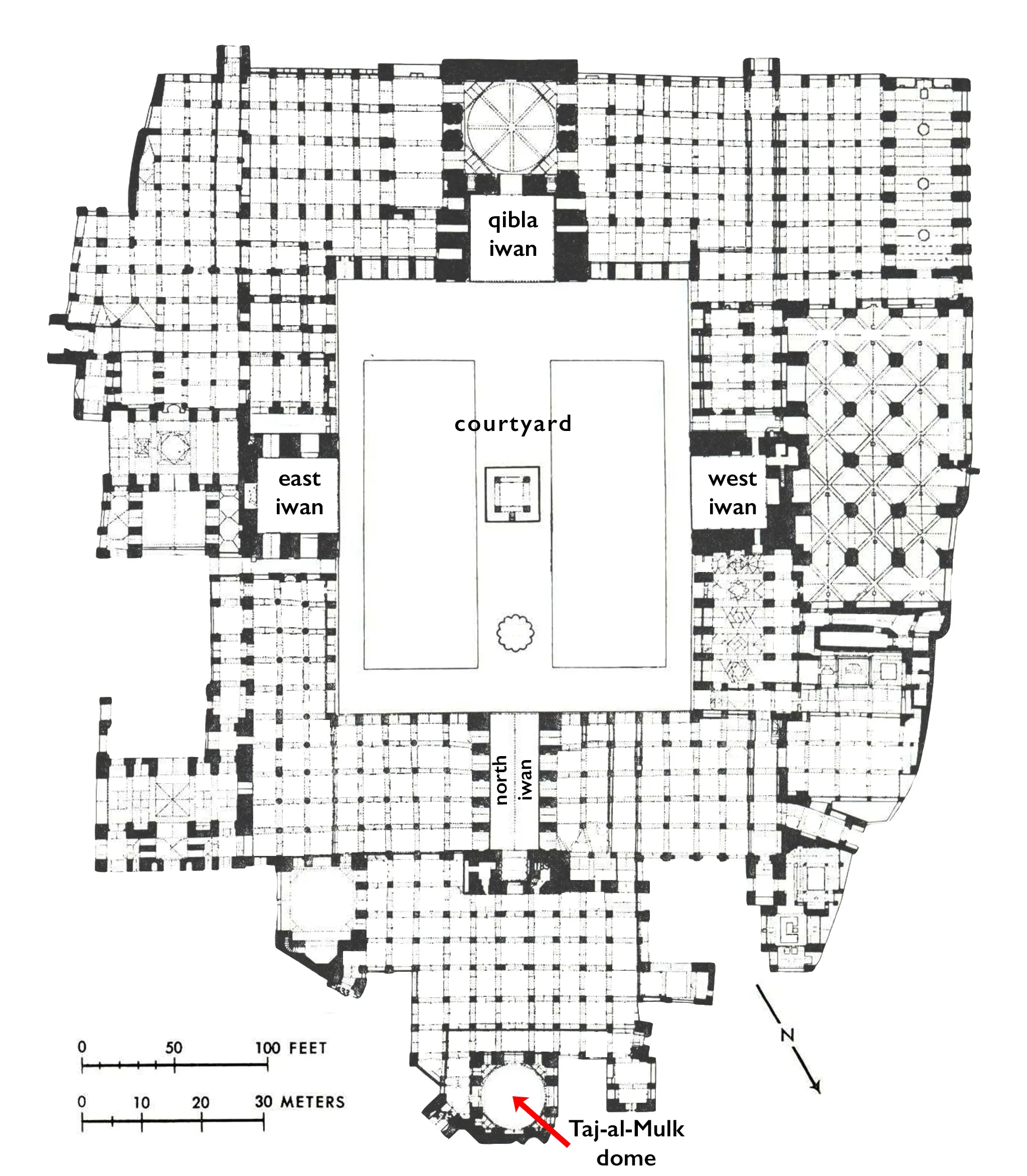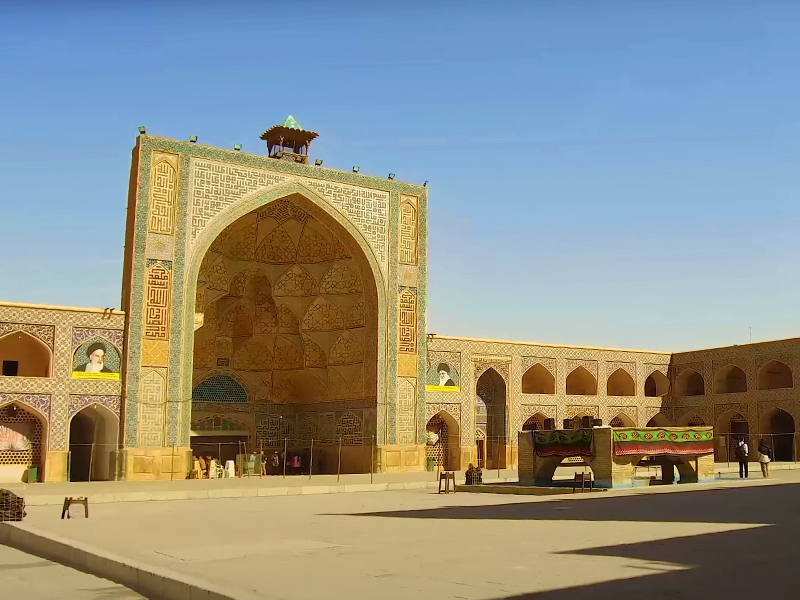Jameh Mosque of Isfahan: Photos, History, Architecture
Isfahan, known as one of Iran’s most tourist-friendly cities, has a rich tapestry of historical treasures, among which Jameh Mosque of Isfahan is one of the most important and ancient ones. This valuable building, which is also known as the Atigh Mosque, includes different parts that were built in different historical periods. The mosque’s structures, reflecting different architectural styles from different eras, showcase the pinnacle of Iranian Islamic art. Jameh Mosque, with its exquisite architecture, is a great sample of the rich cultural heritage of Isfahan.
Every year, many tourists travel to explore the Masjid-e Atiq and other captivating sites in Isfahan. If you also wish to witness the greatness of this magnificent building in your world adventures, we invite you to delve into the analysis of the Jameh Mosque of Isfahan with us.
Jameh Mosque of Isfahan History
The Jameh Mosque of Isfahan is one of the most significant historical monuments in the city, with its origins tracing back to the 2nd century AH (Islamic calendar). This beautiful structure was initially built in the year 156 AH with modest dimensions according to the population of Isfahan during that period, which shows the trend of urbanization at that time. However, 70 years later, in 226 AH, at the command of Caliph al-Mu’tasim Abbasi, the mosque was destroyed, and a new one with wooden columns was erected, leaving lasting traces.
The most transformative changes occurred during the Seljuk era when architects departed from the Arab mosque model. They introduced a new style by creating four iwans on the four sides of the mosque, giving rise to what became known as the Iranian mosque style. In 515 AH, this mosque was burnt by the Ismailis, resulting in substantial damage. But throughout history, it was rebuilt and restored by different dynasties, including the Ilkhanids, Muzaffarids, Timurids, Safavids, and Qajars. We owe the preservation and glory of this historical diamond to their efforts and dedication.
Who Built the Jameh Mosque of Isfahan?
The Jameh Mosque of Isfahan was originally built in the year 156 AH (777 AD). In 226 AH (846 AD by the order of Caliph al-Mu’tasim Abbasi, the previous mosque was demolished and replaced with a columned structure and a wooden roof.
The most important changes occurred during the Seljuk era when architects departed from the Arab mosque model and introduced a new style with four iwans on the northern, southern, eastern, and western sides, known as the “Iranian mosque” style. In the month of Rabi’ al-Awwal in the year 515 AH (1121 AD), the mosque was burned by the Ismailis but was later restored in the following periods, including the Ilkhanid, Muzaffarid, Timurid, Safavid, and Qajar eras.
Jameh Mosque of Isfahan Architecture
The architecture of the Jameh Mosque of Isfahan is one of the most amazing historical buildings in Iran. The mosque, designed with a quadripartite plan, shows the artistic power of skilled craftsmen and architects from different historical periods. The mosque reflects extensive connections to the old city fabric, with multiple entrances and passageways. The presence of several iwans in the Jameh Mosque is a distinctive feature of Iranian mosque architecture.
Various elements such as stuccos, tiles, and muqarnas have been used to decorate different parts of the mosque, creating visually stunning and masterful designs. The domes in the mosque initially had four sides and later evolved into octagonal, hexadecagonal, and finally circular shapes.
Noteworthy inscriptions in the Jameh Mosque include the names of kings like Shah Abbas Safavi and Malikshah Seljuki, as well as various ministers such as Khwaja Nizam al-Mulk and Mohammad Hossein Khan Sadr. The primary construction material used for the mosque is brick, complemented by the use of raw bricks in certain areas.
The brick columns, divided into two, three, and four sections, the quadripartite iwans, dome squinches, and more contribute to the marvels of the mosque’s architecture. Yusef Isfahani is credited as the architect responsible for the creation of the dome’s squinches in the Jameh Mosque of Isfahan.
Isfahan Mosque Ceiling
The dome and forty surrounding columns in the southern portico of the mosque were built between the years 465 to 485 AH (1072 to 1092 AD). This dome was built during the reign of Malikshah Seljuk and the ministry of Khwaja Nizam al-Mulk, representing a rare example of Seljuk-era architecture.
The brick portico in front of this dome, built in the early 6th century AH (12th century AD), has a ceiling decorated with intricate stucco decorations, making it one of the most beautifully decorated structures with brick and plaster designs.
Jameh Mosque of Isfahan Entrance
The Jameh Mosque of Isfahan has different entrances, and its surrounding passageways and thoroughfares indicate extensive connections with the old city fabric. This mosque is built in a rectangular shape and has ten entrances. In addition, it includes several iwans, minarets, a library, and more.
The eastern section and its entrance, along with the mausoleum of Allameh Majlisi in the northwest, underwent restoration during the Qajar era under the rule of Fath-Ali Shah. The southern entrance gate of the dome is adorned with Kufic inscriptions of verses from Surah Aal-e-Imran, which are beautifully worked with raised bricks beneath a large crescent.
Jameh Mosque of Isfahan (Isfahan Pool)
The Jameh Mosque of Isfahan is constructed in a rectangular shape and has two pools. One pool, with a four-sided design, is located in the central courtyard, while another polygonal pool is situated in the northern part of the building. The four-sided pool has a structure with four columns and several steps. By viewing the Jameh Mosque of Isfahan photos, you can appreciate the beauty of the mosque and its pools.
This building probably dates back to the Safavid era, possibly during the reign of King Shah Mohammad Khodabandeh. Originally built to serve religious purposes during the summer and as a place for pilgrims to practice, this site has historical significance.
According to another account, it was built during the Albooyeh dynasty. It is said that when the disciples of Ibn Abbad (a scholar, writer, poet, and minister) increased significantly, and the sound could not reach from the southern portico to the other side, someone would stand on this structure to relay the news to others.
Jameh Mosque of Isfahan Reviews
Visitors on TripAdvisor often highlight its serene atmosphere and authenticity, with one traveler from Cairo calling it “more authentic, less touristy, very welcoming”.
Iranian reviewers describe it as “where more than 900 years of Persian architecture are revealed,” praising its four‑iwan courtyard, elaborate mosaics, and soaring domes.
Architecture enthusiasts, too, are left in awe by its geometric complexity—Reddit users call it “mind‑boggling” to the point it “reminds me of a DMT trip,” and admire that those intricate facades are made from tiny tiles, not paint.
Together, these reviews paint a portrait of a site that is not just historically rich and visually stunning, but also imbued with a genuine sense of spirituality and discovery for every visitor.
Jameh Mosque of Isfahan Location
The Jameh Mosque, known as the Friday mosque of Isfahan, is located in the old quarter of Isfahan at the end of the Isfahan Grand Bazaar. To reach this historic mosque, you have to move towards Qiam Square and navigate through Allameh Majlisi Street. Public transportation is a good option to reach Jameh Mosque, with the nearest metro station being Shohada Square Station. If using private transportation, visitors can reach the mosque by connecting from Ibn Sina, Hafez, Abdulrazzaq, Kamal, or Valiasr Streets to Majlisi Street. The strategic location of the mosque within the heart of the city makes it easily accessible for both locals and tourists eager to explore its architectural splendor (Location on map)
Final Word
The Jameh Mosque of Isfahan is a living chronicle of architectural brilliance and historical significance. Its rectangular structure, adorned with two intricately designed pools, presents a unique glimpse into the past, possibly dating back to the Safavid or Albooyeh eras. Beyond its historical charm, the mosque invites visitors to appreciate the craftsmanship of its builders and the subtle beauty embedded in its design. Visiting this magnificent and unique mosque will introduce you to the rich Iranian culture and architecture and bring you a unique experience, so be sure to include it in your schedule.
Are you planning to travel to Iran and looking for an Iranian travel agency? Please read things to do in Isfahan and Check out our Iran tours.
Watch the second part of Jameh Mosque of Isfahan Virtual Tour!









Leave a Reply
Want to join the discussion?Feel free to contribute!